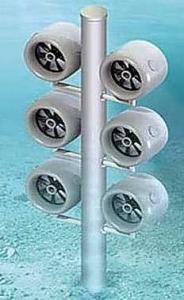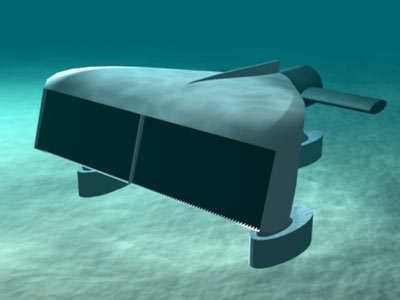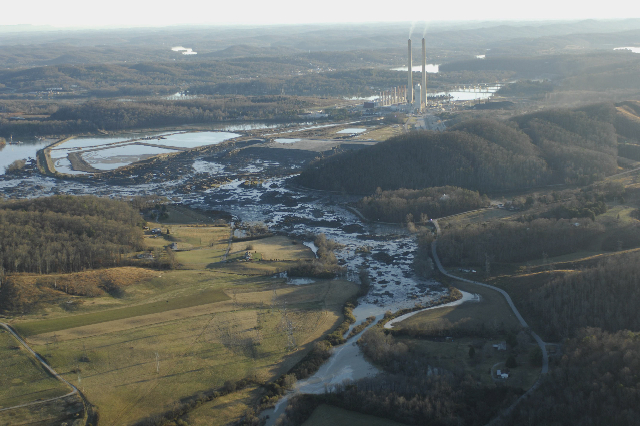EPA objects to Big Stone II air permit
January 23rd, 2009
EEEEEEE-HAAAAAAAA! A big stake in its slimy little heart…
Hot off the press from Sierra Club and Clean Water Action, who have been working tirelessly against Otter Tail Power’s Big Stone II coal plant, the Big Stone II air permit is upende
Here’s their press release in toto:
FOR IMMEDIATE RELEASE:
CONTACT:
Virginia Cramer, Sierra Club 804-519-8449
Darrell Gerber, Clean Water Action 612-802-5372Date: January 23, 2009
Big Stone II Sent Back to the Drawing Board
U.S. Environmental Protection Agency Concerned About Pollution, Global WarmingWashington, DC – Less than three days after the Bush Administration left office, the Environmental Protection Agency (EPA) has overturned the State of South Dakota’s approval of the massive Big Stone II coal-fired power plant. The EPA’s decision comes after the state failed to require state-of-the-art pollution controls for the coal plant that would address concerns about harmful soot, smog and global warming pollution.
“This is a great day not only for clean energy and people’s health, it’s a victory for the rule of law,” said Bruce Nilles, Director of the Sierra Club’s Move Beyond Coal Campaign. “EPA is signaling that it is back to enforcing longstanding legal requirements fairly and consistently nationwide,” added Nilles.
As the first major coal plant decision by the EPA since President Obama took office, this decision signals that the dozens of other coal plant proposals currently in permitting processes nationwide will face a new level of federal scrutiny. Sierra Club and Clean Water Action have been working to stop the Big Stone II project and ramp up clean energy investments in for more than three years.
“Today EPA took the first step toward restoring science and integrity to its work and recognizing the very real need to reduce air pollution from coal-fired power plants,” said Darrell Gerber, Clean Water Action Program Coordinator. “Downwind residents and the region’s natural resources will be better protected.”
This decision likely spells the end of Otter Tail Power’s Big Stone II coal plant. While for the past eight years the Bush Administration has refused to regulate global warming pollution, even after being ordered to do so by the US Supreme Court, President Obama has pledged that the US will cut global warming pollution and do its part to avoid the worst consequences of climate change. With coal-fired power plants accounting for almost 30% of our nation’s carbon dioxide emissions, burning less coal and investing in clean energy such as wind and solar instead is a common sense approach to helping meet global warming pollution reduction goals. The proposed Big Stone II 500-megawatt coal plant would have emitted more than 4 million tons of global pollution annually.
At a minimum, Otter Tail Power will have to go back to the drawing board and redesign the project to incorporate the best and maximum available control technology for pollution like soot and smog. Sierra Club and Clean Water Action will be pushing for EPA to set limits also for carbon dioxide, the main contributor to global warming.
“Otter Tail Power will now have to be responsible for the cost of its pollution,” said Nilles. “We hope that this increasing cost of coal will encourage Otter Tail Power, along with Governors Pawlenty and Rounds, to harness the clean and affordable wind resources available in the region. Minnesota and South Dakota should be leaders on the path to renewable energy independence, not laggards proposing 19th century coal plants.”
###
Now, can we get them to end Excelsior Energy’s Mesaba Project?
DNREC settles with NRG for ~ $1.00 per violation!
January 8th, 2009
Horse’s Ass Award to DNREC’s John Hughes and (not-soon-enough) outgoing Gov. Minner (can’t have Delmarva Power’s Todd Goodman thinking he’s the only one!):
Let’s think a bit here… why this settlement? What would make it worth their while?
NRG has been belching pollution forever, violating federal rules, violating the Clean Air Act. For years this has been an issue, Green Delaware at the head of the charge. There’s been building attention and recently, Citizens for Clean Power filed Notice of Intent to Sue (below). And now, at the last minute of the Minner administration, DNREC does a deal with NRG that is so slimy, rolling over in a way that is less than a slap on the wrist to NRG and which could be just barely enough to prevent a suit by Citizens for Clean Power. And what if this had been filed at the END of November to put Markell on notice that he was expected to act, taking away that power to do an end run from Minner’s administration?
Here’s the 60 day notice filed on behalf of Citizens for Clean Power:
Here are some Green Delaware Alerts about NRG’s Indian River Power Plant:
And from the Archives:
Green Delaware Alert 238 – Minner administration proposes reduced reporting of SO2 releases
Green Delaware Alert 302 – Where does Delaware’s mercury come from?
Green Delaware Alert 499 – What problems are fundamental? Will our legislators tackle them?
Green Delaware Alert 506 – A decision time for power plant pollution in Delaware
For more from Green Delaware on NRG, go to www.greendel.org and search for NRG
From the News Journal yesterday and today:
This came over the wire today from Pat Gearity, Citizens for Clean Power, who have been leaning hard on NRG, that’s their mission:
Dear supporters of clean air:
Two months ago, CCP filed a 60-day Notice of Intent to Sue NRG’s Indian River Power Plant for over 5,000 violations of federal law from 2004-2008, including exceedances of nitrous oxide emissions and the opacity standard (a measure of particulate density discharged from the stacks). By law, DNREC and Governor Minner were also notified. Yesterday, DNREC announced its own lawsuit against NRG for the very violations CCP has alleged and that the agency has done nothing about since 2004. Why did DNREC take this action exactly 60 days before CCP could file its lawsuit? BY ENTERING INTO A TOKEN SETTLEMENT WITH NRG, DNREC AND JOHN HUGHES ALSO ATTEMPT TO BAR THE FILING OF CCP’S LAWSUIT.
On what basis did NRG Indian River solicit DNREC’s legal action to stop CCP’s impending citizen suit? Under the Clean Air Act, “diligent prosecution” in a court by a state agency precludes a private citizen suit if the agency files before the citizen suit can be filed.
On his way out the door, John Hughes took care of NRG again. Under a citizen lawsuit, IRPP could have been fined as much as $32,500 per violation and could have been ordered to pay additional funds to mitigate the environmental damage. Instead, the Secretary and the Agency stepped in to try to stop us for $1.00 per violation and a few token changes, with no environmental mitigation penalties.
NRG’s profits from IRPP make it a mega-million $ “cash cow” for the company. DNREC’s attempted interference with citizen’s rights is disgraceful. Change is desperately needed at DNREC. Please write Governor-elect Jack Markell at: Jack Markell <campaign@markell.org> or call him at 302 672-6700. Ask him to appoint a Secretary who will put public health, safety and corporate accountability above industry profit.
Please forward this email to interested persons. CCP’s 60-day Notice Letter to NRG is attached FYI.
Pat Gearity, Citizens for Clean Power
CITIZENS DECRY DNREC ATTEMPT TO PREVENT PRIVATE LAWSUIT AGAINST INDIAN RIVER POWER PLANT
LEWES, DELAWARE, January 7, 2009 – Citizens for Clean Power charged today that the Delaware Department of Natural Resources and Environmental Control (DNREC) is attempting to bar the filing of a private citizen lawsuit against the NRG-owned Indian River Generating Station (IRGS) for over 5,000 violations of the federal Clean Air Act since 2004, by filing its own lawsuit and pursuing only nominal penalties from the company.
On November 6, 2008, the Mid-Atlantic Environmental Law Center, representing Citizens for Clean Power (CCP), provided notice of intent to sue NRG affiliate Indian River Power, LLC, the operator of the power plant (IRGS) in Millsboro, Delaware. On January 5, 2009, one week before CCP could file its case by law, DNREC filed its own lawsuit against Indian River Power. DNREC’s suit mirrors the charges made by CCP. CCP’s notice letter charged that IRGS has violated provisions of the Clean Air Act, its Title V Operating Permit, and the emission limitations in various federal and state rules
and permits. The letter identified violations of state and federal opacity standards and nitrogen oxide standards from all four operating units at the plant. In its notice, CCP alleged that IRGS committed more than 4400 opacity violations and 771 violations of nitrogen oxide standards dating to 2004, and indicated the suit would seek financial penalties and injunctive relief to ensure future compliance.“We have complained to DNREC about the pollution from this plant for years, but until our lawsuit approached, DNREC consistently declined to enforce the law,” William Zak, co-founder of Citizens for Clean Power, said. “Despite Indian River Power Plant being the biggest polluter in the state, DNREC has now essentially acted on the plant’s behalf to halt the meaningful deterrence and compliance-inducing injunctive relief we would seek through our suit,” Zak continued.
Each time that Indian River violated its permit and the underlying regulations a separate violation of the Clean Air Act occurred. Under a private citizen lawsuit, each violation can result in maximum civil penalties of up to $32,500. Proceeding under state law, DNREC’s suit indicates it is authorized to seek financial penalties against the plant between $1,000 and $10,000 per violation. But the reality is
far, far lower. The filed Consent Order from DNREC, agreed to by Indian River Power, features a $5,000 penalty, along with other minor requirements.“The pattern of opacity non-compliance at Indian River is so extensive that only significant penalties designed to deter future violations and an upgrade in particulate matter pollution controls will resolve the situation,” said Michael Fiorentino of Mid-Atlantic Environmental Law Center, Counsel to CCP. “At less than a dollar per incident, violating the Clean Air Act has never been this cheap.”
Zak was outraged by word of DNREC’s settlement. “It’s a major slap in the face to the public and particularly to the citizens of eastern Sussex County, who have been breathing toxic pollution from the Indian River plant for more than fifty years, with little or no advocacy by the one state agency charged with protecting them,” Zak said.
——————-
——————-
As Pat Gearity reports, they’re not done with this yet… stay tuned for the rest of the story!
TVA coal ash slide – UPDATES
December 27th, 2008
The only good news in this is that the media is picking this up, it’s not going to be “disappeared.”
From the “field” or from the slime, muck & yuck, here are updates. Special thanks to United Mountain Defense, John Walthen, Nicholas Mann, Tom Swinford, Chris Irwin, Donna Lisenby, Dot Griffith, and all those doing tremendous work getting the word and pictures out (whose names haven’t shown up in the emails I’ve received). This is a clear example of the importance of the internet.
Here’s from The Tennessean:
Would you believe 5.4 million cubic yards? Can you even imagine that?
A video from the scene by people taking water samples on the Emory River:
There is a great collection of photos on Photobucket:
A general view of the devastation, being downplayed by TVA and the coal industry:
Here you can watch the cops clearing out the area (at the end), can’t have this showing up on YouTube, don’t cha know:
And this photo by Dot Griffith puts it all together:
Hydrokinetic Power in MN
December 18th, 2008

I’ve been hearing rumblings, and finally am getting around to doing the background on this, and I was shocked and most pleased to find that there are FOUR projects proposed for Minnesota. FOUR! One each at Lock and Dams 2, 3, 4, and 7.
Lock and Dam #2 is in Hastings, and that project has been issued a permit by FERC – here’s the permit (the application isn’t there, they’ve got a link mix-up that I hope will be fixed):
Here are the other ones that I could find on the FERC site. First is the one for the Lock & Dam by Red Wing, immediately south of the Prairie Island nuclear plant:
After the applicants fix the holes in the application, FERC will have a comment period, probably at least 30 days, I need to look at one that’s been through the process to be sure.
And here we are going south — the Lock & Dam numbers go up as they go south:
This is new, and needs vetting, but I’m excited at this possibility, particularly as back up for wind for dispatchable power. And I really like that it’s right here in Red Wing. The Red Wing project is 11 MW, 1% of Prairie Island, but from the FERC site, the projects already on track equal 1500+ MW, and that’s 1.5 Prairie Islands, and that’s significant! One issue of concern, in addition to fish impacts (do you see fish screens on either of these pictured?), is the implications of further dependency on water for power generation. There is already concern in the transmission world about the impacts of low water level on power plants, the concern being that if the water’s really low, they shut down, and then what does that do to the grid generally (crash it?). Increased dependence on water will amplify that problem, I’d think. On the other hand, the hydrokinetic generation doesn’t take water, it just passively uses it, unlike the millions of gallons a day going through a coal or nuclear plant with a percentage going up into the air through cooling towers and not into the river.
Here’s one of those intense regulatory process charts with circles and graphs and arrows and lots of colors:
Here’s some FERC info:
And from Fish & Wildlife:
Fish & Wildlife Service – Mississippi River Primer & Concerns
Oh, and duh, here’s the rules:
Speaking of cooling towers, there’s a hydrokinetic project proposed for NRG’s Indian River Power Plant, in the water intakes or discharge… gotta check that out, and it will be on a following post. But the issue with that project is that the hydrokinetic project may be used as justification not to go to a cooling tower or zero water system… so… it’s mixed…
Here’s another version of a hydrokinetic turbine:

CO2 concerns prevail in amazing EPA appeal
November 13th, 2008
In a Sierra Club air permit challenge, the Environmental Appeals Board has ruled that the EPA must address CO2, and it remanded “the permit to the Region for it to reconsider whether to impose a CO2 BACT limit and to develop an adequate record for its decision.” This decision should apply to air permits for facilities discharging CO2, pretty much everything, eh?
Here’s a snippet about alternatives, because this is what the EPA Comments are very concerned about in the Mesaba case:
The statutory section Sierra Club relies upon, CAA section 165(a)(2), does not require the permit issuer to independently raise and consider alternatives that the public did not identify during the public comment period. Here, Sierra Club did not identify during the public comment period the alternatives it raises in its petition.
So Sierra’s alternatives argument got 86’d (p. 6). But here’s some good stuff:
Although the Supreme Court determined that greenhouse gases, 2 such as CO , are “air pollutants” under the CAA, the Massachusetts 2 decision did not address whether CO is a pollutant “subject to regulation” under the Clean Air Act. Massachusetts v. EPA, 549 U.S. 497, slip op. at 29-30 (2007); In re Christian County Generation, LLC, PSD Appeal No. 07-01, slip op. at 7 n.12 (EAB Jan. 28, 2008), 13 E.A.D. at ___. The Region maintains that it does not now have the authority to impose a CO BACT limit because “EPA has historically interpreted the term ‘subject to regulation under the Act’ to describe pollutants that are presently subject to a statutory or regulatory provision that requires actual control of emissions of that pollutant.” U.S. EPA Region 8, Response to Public Comments (Permit No. PSD-OU-0002-04.00) at 5-6 (Aug. 30, 2007) (“Resp. to Comments”). We hold that this conclusion is clearly erroneous because the Region’s permitting authority is not constrained in this manner by an authoritative historical Agency interpretation.
But then they wiggle a bit and then clarify that they’re just sending it back:
By our holding today, we do not conclude that the CAA (or an 2 historical Agency interpretation) requires the Region to impose a CO BACT limit. Instead, we conclude that the record does not support the 2 Region’s proffered reason for not imposing a CO BACT limit – that 2 although EPA initially could have interpreted the CAA to require a CO BACT limit, the Region no longer can do so because of an historical Agency interpretation. Accordingly, we remand the Permit to the Region 2 for it to reconsider whether or not to impose a CO BACT limit and to develop an adequate record for its decision.
The timing is good, with Pres. Obama about to walk in the door. But what will Bush do in the remaining time?
AAAAAAAAAAAAAAAAAAAAAAAGH!







